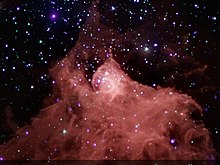List of star-forming regions in the Local Group
Appearance

This is a list of star-forming regions located in the Milky Way Galaxy and in the Local Group. Star formation occurs in molecular clouds which become unstable to gravitational collapse, and these complexes may contain clusters of young stars and regions of ionized gas called H II regions. Stars typically form in groups of many stars, rather than in isolation.[1]
Galactic Star-Forming Regions
| Name | RA [deg] | Dec [deg] | l [deg] | b [deg] | Distance [pc] | Age [Myr] | Earliest SpTy | Number of Stars | Cloud Mass [Mo] |
|---|---|---|---|---|---|---|---|---|---|
| Corona Australis Molecular Cloud | 287.368 | -37.904 | 130 | ||||||
| Rho Oph | 247.025 | -24.541 | 353.22 | 16.53 | 131 | ||||
| Taurus Molecular Cloud | 070.25 | +25.87 | 174.13 | -13.45 | 140 | ||||
| Orion Nebula | 83.8221 | -5.3911 | 209.013 | -19.382 | 415 | ||||
| W40 | 277.871 | -2.090 | 28.791 | +3.481 | 500 [2] | 0.8 [3] | late-O [2] | 520 [4][5] | |
| RCW 36 | 134.7537 | -43.0 | 265.0794 | +1.4048 | 700 | ||||
| Vela Molecular Ridge | 134.7537 | -43.0 | 265.0794 | +1.4048 | 700-1000 | ||||
| Cygnus X | 307.5 | 41.0 | 1400 | ||||||
| NGC 6334 | 260.212 | -36.115 | 351.42 | +0.64 | 1700 | ||||
| NGC 6357 | 261.62 | -34.20 | 353.11 | +0.65 | 1700 | ||||
| Eagle Nebula | 274.700 | -13.807 | 16.95 | +0.793 | 1750 | ||||
| M17 | 275.196 | -16.172 | 15.06 | -0.69 | 2000 | ||||
| Carina Nebula | 161.285 | -59.868 | 2600 | ||||||
| AFGL 2591 | 307.354 | 40.189 | 078.887 | +0.709 | 3300 [6] | O9–O6 [7] | |||
| W43 | 281.885 | -01.942 | 30.759 | -0.019 | 6000 | ||||
| W49 | 287.582 | +9.128 | 43.200 | +0.000 | 11000[8] | O2-3.5If*[9] | |||
| Radcliffe wave[10] |
Extragalactic Star-Forming Regions
| Name | RA [deg] | Dec [deg] | l [deg] | b [deg] | Distance [pc] | Age [Myr] | Earliest SpTy | Number of Stars | Cloud Mass [Mo] |
|---|---|---|---|---|---|---|---|---|---|
| 30 Doradus | 84.67665 | -69.10093 | 279.4652 | -31.6719 | 49,000 |
See also
- RCW Catalog – astronomical catalogue
- Sharpless catalog – astronomical catalogue
- Gum catalog – astronomical catalog of emission nebulae
- List of nearest stars and brown dwarfs
References
- ^ Lada, C. J.; Lada, E. A. (2003). "Embedded Clusters in Molecular Clouds". Annual Review of Astronomy & Astrophysics. 41: 57–115. arXiv:astro-ph/0301540. Bibcode:2003ARA&A..41...57L. doi:10.1146/annurev.astro.41.011802.094844.
- ^ a b Shuping, R. Y.; et al. (2012). "Spectral Classification of the Brightest Objects in the Galactic Star-forming Region W40". Astronomical Journal. 144 (4): 116. arXiv:1208.4648. Bibcode:2012AJ....144..116S. doi:10.1088/0004-6256/144/4/116.
- ^ Getman, K. V.; et al. (2014). "Age Gradients in the Stellar Populations of Massive Star Forming Regions Based on a New Stellar Chronometer". Astrophysical Journal. 787 (2): 108. arXiv:1403.2741. Bibcode:2014ApJ...787..108G. doi:10.1088/0004-637X/787/2/108.
- ^ Kuhn, M. A.; et al. (2010). "A Chandra Observation of the Obscured Star-forming Complex W40". Astrophysical Journal. 725 (2): 2485–2506. arXiv:1010.5434. Bibcode:2010ApJ...725.2485K. doi:10.1088/0004-637X/725/2/2485.
- ^ Kuhn, M. A.; Getman, K. V.; Feigelson, E. D. (2015). "The Spatial Structure of Young Stellar Clusters. II. Total Young Stellar Populations". Astrophysical Journal. 802 (1): 60. arXiv:1501.05300. Bibcode:2015ApJ...802...60K. doi:10.1088/0004-637X/802/1/60.
- ^ Johnston, K. G.; Shepherd, D. S.; Robitaille, T. P.; Wood, K. (2013). "The standard model of low-mass star formation applied to massive stars: a multi-wavelength picture of AFGL 2591". Astronomy & Astrophysics. 551: A43, 1–23. arXiv:1212.1719. Bibcode:2013A&A...551A..43J. doi:10.1051/0004-6361/201219657.
- ^ Sanna, A.; Reid, M. J.; Carrasco-González, C.; et al. (2012). "Clustered star formation and outflows in AFGL 2591". The Astrophysical Journal. 745 (2): 191–200. arXiv:1111.0843. Bibcode:2012ApJ...745..191S. doi:10.1088/0004-637X/745/2/191.
- ^ Zhang, B.; et al. (2013). "Parallaxes for W49N and G048.60+0.02: Distant Star Forming Regions in the Perseus Spiral Arm". Astrophysical Journal. 775 (1): 79. arXiv:1312.3856. Bibcode:2013ApJ...775...79Z. doi:10.1088/0004-637X/775/1/79.
- ^ Wu, S.-W.; et al. (2014). "The discovery of a very massive star in W49". Astronomy & Astrophysics. 568: L13. arXiv:1407.4804. Bibcode:2014A&A...568L..13W. doi:10.1051/0004-6361/201424154.
- ^ editor, Ian Sample Science (7 January 2020). "Astronomers discover huge gaseous wave holding Milky Way's newest stars". The Guardian. ISSN 0261-3077. Retrieved 2020-01-07 – via www.theguardian.com.
{{cite news}}:|last1=has generic name (help)
